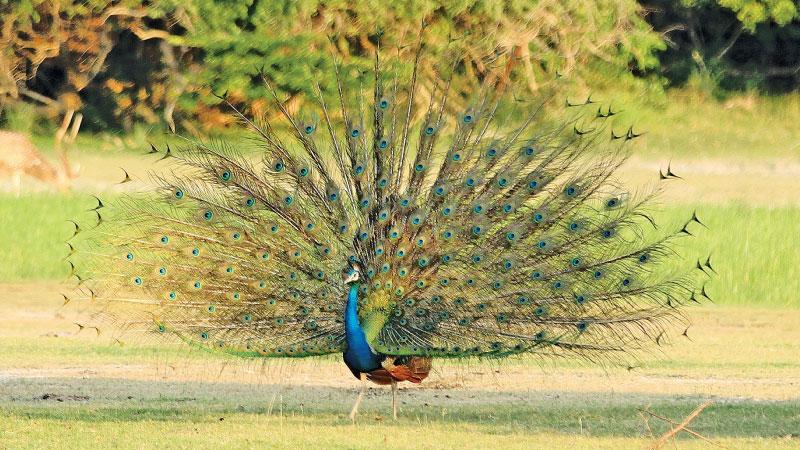
Have you ever seen a clever, shy, vain and gorgeous bird that is considered the most dazzling jewel in nature’s showcase? That is the exotic peacock. The people living in Sri Lanka and India are lucky to see peacocks which have given rise to many legends and myths around the world.
The peacocks we see in Sri Lanka and India are noted for their resplendent trains of long upper tail coverts which conceal their relatively short tails. Peacocks raise their plumage and spread it in strutting displays. You may have seen that the feathers are generally an iridescent green and gold. They are ornamented with eye-like markings of a rich colour, known as peacock blue. The same blue colour appears on its head, neck, breast and crest. Peahens have no trains and are less colourful than the male bird. They build their nests on the ground or in the low branches of trees. They eat worms, insects, small snakes and seeds.
I first spotted a peacock in the dense jungle close to Kataragama in the 1940s. It stood tall as an eagle in a clump of trees. Since then, I have never seen a more exotic bird than the peacock. As a child,I moved slowly towards the peacock to have a better view of the wonderful bird. The peacock was simply staring at me. My father did not allow me to go further. When I visited Kataragama some years later, I found so many peacocks and also vendors selling peacock feathers. Some people believe that keeping peacock feathers in a house might lead unmarried girls to end up as old maids.
Tiny tail
After a few hours of coming out of the egg, the young male peacock raises its tiny tail in a strut. It usually takes about two years for the train plumage to develop into its full capacity. By that time, the train projects beyond the tail from 40 to 50 inches giving the peacock its magnificent tail-train 55 to 72 inches long. The peacock lives for about 30 years. During its lifetime, the train feathers turn bronze green with a copper sheen near the tips. Each feather will have a distinct eye formed by a blue heart-shaped spot ringed with blue green, golden-bronze, gold and rich brown. Nature has not endowed such a colour combination on any other bird. Only when unfurled will you see the fantastic fan showing its spectacular colours taking the shape of a shield from which a thousand eyes seem to peer. I still remember those beautiful eyes when a peacock did a fan dance at Kataragama many moons ago.
It is generally believed that peacocks strut only when they are surrounded by peahens. However, I have seen peacocks dancing away happily even when there were no female birds around. Even when the peacock dances in the presence of peahens, the latter do not take any notice of the dancer. Sometimes, peahens do not even lift their heads to see what the peacock is doing.
There are many legends and myths surrounding the peacock. The peacock was domesticated in Judea during the time of Solomon and later it was brought to Greece by Alexander the Great. According to a Roman legend, Juno transposed the hundred eyes of Argus, slain by Mercury, to the peacock’s tail. A jungle legend says peacocks and snakes are mortal enemies. William Beebe, a naturalist, had seen a peacock playing with a deadly viper. However, the peacock had not tried to kill the viper.
Folk tales
According to some folk tales, peacocks were found in the Garden of Eden. Arabs considered the peacock as a bird of ill omen. Some people believe that the peacock had been the cause of the entrance of the evil into Paradise leading to the expulsion of Adam and Eve from the garden. It was believed that the devil watered the vine with the blood of the peacock. A Persian proverb says, “The peacock is always happy because it never looks at its ugly feet.” It means that a person does not see their own faults.
The peacock’s cry was believed to predict the coming of wet weather. It sounds like a child’s plea for ‘help.’ But very often the peacock’s cry resembles the cry of an old tomcat, a cross between a ‘miaow’ and the clear sound of a trumpet. Sometimes the peacock utters a shrill ‘ka-oan-ka-oan’ call. If you go on a safari to the Yala National Park, peacocks are a common sight. In Sri Lanka peacocks are found in the jungles of the Eastern, Northern and Southern Provinces. If you are driving through Hambantota, you can see them strolling on the streets.
Hindus in Sri Lanka have a special place for peacocks as Skanda, the God of Kataragama, sits with his wives and peacocks on either side. Lord Vishnu is often depicted with a peacock in the background.
Ornaments
According to naturalists, the peacock is one of the most alert of jungle creatures. It is as sinuous as a snake, as stealthy as a cat, and as wary as an old bull bison in watching for foes. However, peacocks are kept on the lawns of stately homes and in zoological gardens. They are mostly kept as ornaments but not as pets. People who keep them claim that peacocks are captivating birds.
In his 1836book On the Mental Illumination and Moral Improvement ofMankind Re. Thomas Dick pays the highest tribute to the peacock calling it “The most beautiful bird in the world.” However, at various times and I various cultures, the peacock has served as a symbol of good and evil, deatThe Arabian Nights depicts the peacock as a good-hearted bird which helped other animals in distress while condemning man’s ingratitude to man and other beasts.
